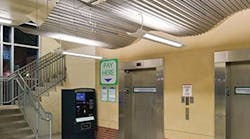How safe is your parking lot or garage? From personal theft and assault to vandalism and public intoxication, a parking area can supply perpetrators with easy targets and tempting assets.
Despite a garage or lot’s vulnerabilities, facility managers have an arsenal of security tools and design measures they can implement to create a safer parking environment. Focus on these four strategies to protect occupants, their valuables, and your property.
Expand Maintenance
Often overlooked, parking lot and garage upkeep is a valuable security tactic.
“If a parking area is dirty, has a poor layout, or looks unsafe, clients and visitors develop a negative image for that business,” says G. Robert Harkins, associate vice president for Campus Safety and Security at the University of Texas at Austin, which houses 15,000 parking spaces over multiple lots and nine garages.
Would-be aggressors also interpret an unkempt parking area as a sign that the property isn’t monitored. A poorly maintained lot or garage suggests it will be easier to commit a crime because no one from management will thwart or catch unwanted activity.
Routine janitorial duties like picking up litter, emptying garbage bins, trimming landscaping, and addressing odors are simple measures with noticeable results. In garages, glass elements, stairwell rails, signage, and elevator interiors should receive periodic cleanings as well.
Consider yearly touch-ups to paint and deep cleaning for lighting fixtures that have become dingy. Concrete floors can also be pressure washed to remove skid marks, oil stains, dirt, and other debris.
Landscaping can serve as a passive barrier if properly maintained, but overrun ledges and trees can create blind spots. “Landscaping should be non-intrusive. It shouldn’t create places to hide or interfere with a person’s visibility of their surrounding environment,” says Harkins, who is also the co-chair of the International Parking Institute’s (IPI) Safety and Security Committee.
[slideshow]
Focus on Lighting
Give your lighting a hard look, stresses Geary Robinson, parking and transportation services director for Indiana University – Purdue University Indianapolis (IUPUI) and a member of IPI. Dark shadows that can conceal aggressors, reduced visibility for pedestrians and vehicles, and inadequate color rendering all chip away at safety.
Not sure if your parking area has a lighting problem? Look at the behavior of visitors. If people feel compelled to use their headlights in your garage or cars are grouped in your lot closest to light poles, these activities indicate that users may be uncomfortable with the level of darkness.
Because no single light source is right for all parking situations, have a lighting consultant evaluate your parking areas, Robinson recommends. Lumens, footcandles, and fixture types are best selected when accounting for site design, particularly for retrofit projects. A consultant can also guide you through options that will address safety and energy concerns.
You can also take advantage of natural light using the same strategies as you would with any building project. Uncluttered layouts, plentiful outside views, transparent interior walls, open stairwells, and glass elevators will bring natural light deep into the space.
“We routinely increase the floor-to-ceiling heights so it allows the throw of light to disperse more. People don’t feel as enclosed if they have more headspace,” says Chris Gray, a project manager with TimHaahs, a firm specializing in parking design.
Another lighting strategy is to use paint. Dark colors may have been popular in the past, but they also absorb light. A new coat of bright paint on the walls and support columns will reflect light and is an inexpensive solution that can simultaneously give the interior a facelift.
For underground or windowless parking garages, use a reflective paint or stain on ceilings and floors – glossy surfaces bounce light more effectively, as opposed to the dull color of concrete used in most garages.
Enhance Surveillance
Use an eye in the sky to monitor parking spaces, entrances, and narrow areas such as stairwells and corridors, Gray recommends. Not only can surveillance catch a crime in progress, but documentation of a vehicle accident, assault, or even a slip-and-fall incident can be valuable.
Beyond the benefits of monitoring, the mere presence of security cameras are sometimes enough to ward off an aggressor, prompting them to seek a less secure target. Surveillance also sends a message to occupants and visitors that their safety is a priority for building management.
As with any surveillance technology, make sure you have appropriate signage announcing the use of cameras so you are in compliance with your jurisdiction’s privacy laws.
The Wave Mixed-Use Parking Facility in Atlantic City, NJ, a TimHaahs project, uses internal and external surveillance. The 1,180-space garage supports the public parking needs of nearby retail, restaurants, hotels, and two convention centers. With a large influx of daily users, surveillance is an invaluable security measure.
In addition to cameras placed within the garage footprint for safety, several 360-degree pan-tilt-zoom (PTZ) units were installed on the top of the exterior stair towers. Not only does parking management have access to the feeds at will, but the external video feed is shared with the police department, explains Gray. It allows them to take advantage of the view from one of the taller structures in the vicinity as well as eliminate a dead spot at a busy intersection.
Don’t overlook the human element of surveillance either. “Parking attendants are another indirect security measure,” Gray observes. “Having someone there 24/7 adds another level of comfort.” You can also tap them to pull double duty and monitor video between clients.
If your garage or lot is unattended, try scheduling frequent patrols, particularly in the evening. If you have contract security, you can also have guards available to escort occupants back to their vehicles.
Improve Access Control
Access control in parking areas addresses two goals – the safe and efficient flow of vehicle traffic and generating a record of parking users.
An open lot may use passive security measures like fences, bollards, and landscaping barriers to outline the parking area and direct users to the proper entrances.
Parking can also benefit from credentials, such as smart and proximity cards, ID badges, issued passes, or window and sticker tags.
Credentials create a pre-approval system, making your garage or lot another checkpoint before people enter your building. Pair them with barriers such as gates and raised arms for added traffic management.
Clearly marked parking spots, crosswalks, and lanes will also safely move people in and out of parking. If there is confusion about where people should be walking or driving, accidents are more likely to occur.
“Good wayfinding signage is also key,” stresses Harkins. “You want people to find their vehicles as efficiently as possible so they’re not wandering around or less aware of their surroundings because they are distracted.”
Justify the Expense
Whether you can use value engineering during the design phase of a parking project to minimize security vulnerabilities or you need to improve your existing parking area, don’t put off security measures.
Because parking doesn’t demand the attention of facility managers like their energy bills or sustainability program, it’s easy for plans to be shelved and maintenance ignored. But if you can’t ensure users’ safety, it’s time to invest in your parking assets.
Don’t forget that while your parking area serves as an amenity for occupants and guests, someone could leverage your asset into a weapon.
The soft costs associated with a major security breach – a negligence lawsuit, a tarnished company reputation, or lost business – can create lasting damage your company may not be able to sustain.
And no building owner wants to be faced with crunching real numbers if an aggressive attack, such as a vehicle bomb, takes place on their property.
“Your return on investment comes into play when you don’t spend more than is originally required to provide a safe environment for your employees, customers, and visitors,” says Robinson. “Ask yourself – if these security options cost me this much today, how much would it cost me if an event compromises my facility? Do I want to become an example of what not to do?”
2 handpicked articles to read next:
Jennie Morton [email protected] is associate editor for BUILDINGS.


